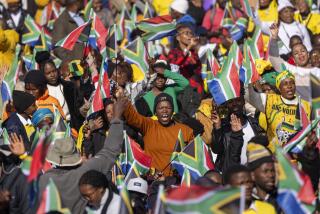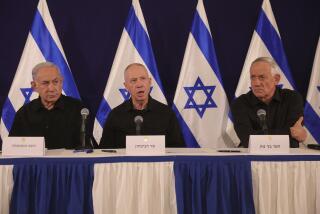New South African Cabinet Looks a Lot Like the Old One
- Share via
JOHANNESBURG, South Africa — Barely 24 hours on the job, President Thabo Mbeki announced changes Thursday in the Cabinet he inherited from former President Nelson Mandela. There were few new faces, however, and he left important economic posts untouched in a reassuring signal to foreign investors.
“We think economic policy in this country is very correct,” Mbeki said in reappointing Finance Minister Trevor Manuel and Trade and Industry Minister Alec Erwin, both respected in the international financial community for their conservative, market-friendly approaches.
Once again, the ruling African National Congress will govern in coalition with its ethnic Zulu-based rival, the Inkatha Freedom Party, which kept three of 28 Cabinet posts. Their alliance over the past five years is credited with the sharp drop in political violence in KwaZulu-Natal province, where the two parties finished neck and neck in June 2 elections.
Inkatha leader Mangosuthu Buthelezi had been rumored as a candidate for deputy president. But in an apparent deal, Buthelezi will continue as minister of home affairs while the ANC supports Inkatha’s bid for the premiership in KwaZulu-Natal, ensuring the province remains in the Zulu party’s hands.
With Buthelezi out of the running, the deputy president’s job went to Jacob Zuma, an ANC stalwart who has been Mbeki’s second in command within the party hierarchy since December 1997. Under a reorganization, however, many of the deputy president’s responsibilities have been folded into the president’s office, which will be headed by a Cabinet minister. Mbeki handed that powerful post to Essop Pahad, an Indian whom he befriended as a student in Britain during the 1960s. Pahad has been one of Mbeki’s top advisors during the past five years.
Mbeki continued the racial balance of Mandela’s Cabinet, with several Indians and people of mixed race keeping positions. Agriculture Minister Derek Hanekom, who is white, was dropped; but another white, Ronnie Kasrils, previously deputy minister of defense, was promoted to minister of water affairs.
Mandela’s Cabinet lost most of its white members in 1996 when the National Party, rulers during apartheid, quit a national unity government formed after the nation’s first all-race elections held two years earlier.
The biggest surprise came with the appointment of Nkosazana Zuma as foreign minister. Zuma, who had been minister of health, has a fiery, divisive style that some say was needed to shake up the country’s health-care industry but that has alienated opposition parties, the U.S. government and international pharmaceutical companies.
Zuma was recruited into the ANC by Mbeki in the 1970s, is related to Mbeki’s wife, Zanele, and was recently divorced from Jacob Zuma. Diplomats and political analysts have described the Foreign Ministry as one of the weakest links in the previous Cabinet. The new foreign minister, as a trusted ally of Mbeki, is likely to change that image, but some question her knack for diplomacy.
Mbeki said Zuma’s posting to the high-profile foreign affairs job was in keeping with his effort to augment the role of women. Female foreign ministers are uncommon in Africa, but Mbeki said he was “committed to the emancipation of women,” whose numbers doubled in his Cabinet, to eight.
Mbeki said his decision to introduce only a handful of new faces was an indication that Mandela’s Cabinet “worked very well.” Opposition leaders, however, said it was a sign that Mbeki favored loyalty over performance.
“The Cabinet is bloated and lacks talent,” said Tony Leon, head of the Democratic Party. “He has reshuffled an already thin pack.”
More to Read
Sign up for Essential California
The most important California stories and recommendations in your inbox every morning.
You may occasionally receive promotional content from the Los Angeles Times.













